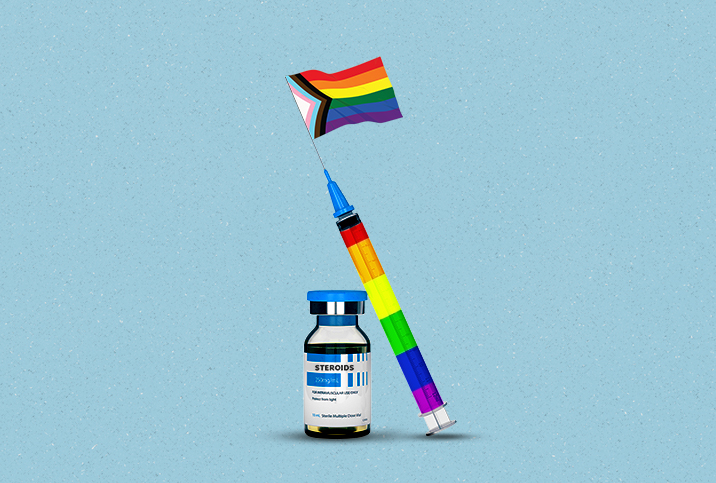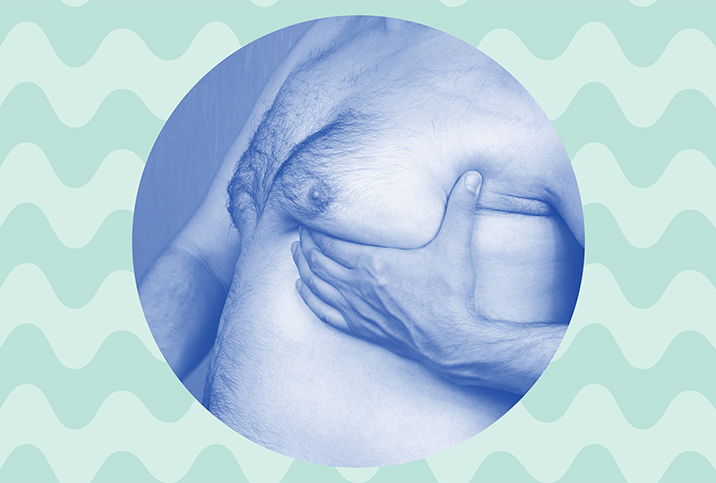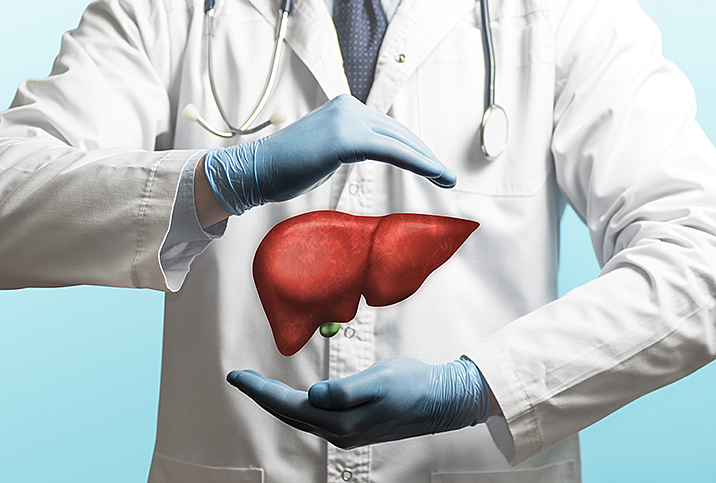The Many Negative Effects of Anabolic Steroids on a Man's Body

Many men yearn for greater muscle mass and strength, and some go to great lengths to achieve an Adonis look or build up their bodies to increase athletic performance—or both. Some men turn to anabolic androgenic steroids (AAS) to attain those results, but the gains can come at a risk and cost to the users.
AAS compounds are considered "anabolic" because they build muscle, and they're referred to as "androgenic" because they increase male sex characteristics, according to the National Institute on Drug Abuse.
But users should be cautious until they know the negative effects of anabolic steroids.
Popular designer AAS substances include bolandiol, clostebol (Steranabol), danazol, drostanolone (Masterone), gestrinone, metandienone (Dianabol), metenolone (Primobolan), oxandrolone (Anavar), oxymetholone (Anadrol), stanozolol (Winstrol), tetrahydrogestrinone (the Clear) and trenbolone (Trenabol), according to an article by Bradley Anawalt, M.D., the chief of medicine at the University of Washington Medical Center. Endogenous AAS that can be used as drugs include testosterone, dihydrotestosterone, boldenone (Equipoise) and nandrolone (Durabolin).
"Anabolic androgenic steroids are by far the most prevalent performance-enhancing drugs to build muscle strength and lean muscle mass," said Laura Lewis, Ph.D., the director of science with the United States Anti-Doping Agency (USADA), in an email. "AAS have both physiological and psychological side effects."
General side effects
USADA's Clean Sport Handbook spells out concerns regarding the effects of AAS on a man's body. Adverse physiological effects of steroids in both men and women can include:
- Acne
- Hair loss
- Liver damage
- Stunted bone growth in adolescents
Unwanted psychological effects might include:
- Increased aggressiveness ("roid rage," more colloquially)
- Increased sexual appetite, sometimes resulting in abnormal sexual and criminal behavior
- Depressive withdrawal symptoms
In men, specifically, the handbook warns about:
- Breast tissue development
- Testicular shrinkage
- Impotence (erectile dysfunction)
- Reduced sperm production
Many effects and side effects of AAS have been well documented, and other effects lead researchers and doctors to speculate that they might be caused by steroid use in men as well.
Muscle mass and strength
Athletes appreciated the muscle-building properties of AAS much sooner than did the scientific community, as Anawalt documented in his 2019 paper. He said one of the first studies to seriously test the effects of testosterone on strength didn't come out until 1996.
"It's one of my favorite studies," he said. "And one of the giants in the field—a colleague and friend of mine [Shalender Bhasin, M.D.]—was the senior author on this. He took a group of men, young, healthy men that were avid exercisers, and he randomized them to four groups."
Half of the participants received 10 weeks of very high doses of testosterone, an injection of 600 milligrams a week, which is at least eight times the amount that normal, healthy men would produce in a week. The other half took a placebo injection. Individuals were randomly assigned to each group, and researchers further split up participants into sedentary and exercise groups.
"You could be on placebo and an exercise group," Anawalt explained. "You could be on placebo and sedentary. You could be a couch potato and get this high dose of testosterone or you could get testosterone and the unnatural size group."
The individuals receiving a high dose of testosterone who didn't exercise still increased their muscle mass and strength. They had significant increases in the cross-sectional areas of their triceps (comparable to those who exercised without receiving the AAS) and quadriceps, and they increased their one-rep max in a squatting lift by 19 percent compared with 21 percent for the placebo-plus-exercise participants. They increased their bench press strength by 10 percent compared with 11 percent for those who exercised without androgen administration.
Not surprisingly, the greatest results occurred among men who took testosterone and exercised. Their quadriceps and triceps grew the most, and their squatting strength increased 38 percent. Their bench strength went up 11 percent more than the participants who exercised while taking the placebo and 12 percent more than those who took testosterone and did not work out.
The dose used in the study was smaller than the amount of AAS many guys who abuse steroids tend to take, Anawalt said. Many men also take the substances for longer than 10 weeks.
Gynecomastia
Men can develop excess breast tissue, also known as gynecomastia, because of the glut of estrogen their bodies produce as a result of AAS use.
"In order to develop breast tissue, you need to have estrogen, and you need to have relatively low amounts of androgen," Anawalt said, adding that estrogen is pro-growth of breast tissue and androgen is anti-growth.
Testosterone can be converted into estrogen in the body, which can encourage undesired breast growth. So men start with a lot of testosterone and not very much estrogen, but then the conversion of testosterone to estrogen causes a percentage increase in estrogen, which might be 100 percent or 200 percent, Anawalt explained.
"When you take testosterone, that drives your estrogen concentrations, percentage-wise, much higher than the changes in your testosterone, and that can result in breast growth," he said.
"Males are particularly vulnerable to breast tissue development, shrinking of the testicles, impotence and reduction in sperm production, the former two of which may be permanent," Lewis added.
Effects on sexual function and libido
A substance like the Clear (tetrahydrogestrinone, or THG) is not aromatizable, so it's not converted into estrogen in the body, Anawalt said.
"Now you're driving your androgen—your testosterone-like levels—very high, but you're actually decreasing estrogen levels," he said. "And the reason for that is that you take that Clear, it goes up to the pituitary and hypothalamus and turns off the production of LH [luteinizing hormone] and FSH [follicle-stimulating hormone] gonadotropin."
This situation contrasts with the use of testosterone.
"The difference is that with Clear, you have lots of androgen and no estrogen," Anawalt said. "When you take testosterone, you have more testosterone, but you have relatively more estrogen."
He said erectile dysfunction (ED) and libido problems probably aren't an issue for someone who is taking only testosterone as opposed to THG, but it's complicated because men who abuse steroids often take multiple AAS substances and/or abuse other hard drugs.
Infertility
Research into androgens suggests AAS can impair the function of the testes, which can induce hypogonadism and negatively affect sperm.
The authors of a 2016 article in Basic and Clinical Andrology, who cited a 2003 review regarding androgens and fertility, suggested that infertility after AAS abuse is commonly attributed to oligozoospermia (low sperm count in semen) or azoospermia (absence of sperm in ejaculate), both of which are associated with abnormalities in sperm motility (movement) and morphology (shape).
If regaining virility is urgent because a man is trying to conceive with a partner—especially if the woman is 30 or older—clomiphene or gonadotropin therapy are options physicians can consider after the patient ceases chronic AAS use, as Anawalt explained in his peer-reviewed paper from 2019.
"If you've been using or abusing anabolic steroids for a year or less, to those men I just say, 'If you stop now, you're likely to recover in the next year or so,'" he said.
'Roid rage'
Anawalt said steroids have been associated with a variety of adverse neuropsychiatric effects, including impulse control, aggression—popularly called roid rage—anxiety and hypomania.
"But we see it in people who are taking really phenomenal doses of anabolic steroids," he said. "Again, these are folks that are taking cocaine, amphetamines, opioids. And so it's a little hard to tease out what causes what. And it's important to make a distinction between taking very high doses of anabolic steroids versus testosterone at normal physiologic levels."
Anawalt acknowledged reports of people experiencing what's assumed to be steroid-induced psychiatric disturbances and anger issues, but he said those cases aren't common.
Liver damage
Steroid clearance occurs in the liver, making hepatotoxicity, or drug-induced liver damage, a concern, as Mark Niedfeldt, M.D., noted in a 2018 article for Current Sports Medicine Reports. Niedfeldt mentioned that long-term use of testosterone cypionate and testosterone enanthate, otherwise believed to have fewer adverse hepatic effects, might increase liver tumor and nodular transformation risk.
Add fatty liver disease as a potential risk of steroid use, according to a study published in Liver International in 2010. Researchers looked at 180 recreational male bodybuilders between August 2007 and March 2009. More than half, 95 of them, had a history of AAS use, while 85 were not users. Testing found criteria for fatty liver disease in a greater percentage of users, intimating steroids could be a risk factor for the disease.
Anawalt said the liver metabolizes testosterone quickly when it's taken orally, so the steroid is sometimes chemically adulterated to make it last longer. The adulterated testosterone—or perhaps an adulterated form of another androgen—taken by mouth is not metabolized in the same way by the liver, if at all.
"Those can be hepatic toxic," he said.
Taking AAS under the supervision of a medical professional is one thing, but abusing the same substances outside of a treatment regimen is quite another, and one that can lead to myriad negative effects of anabolic steroids and potential long-term damage.




















